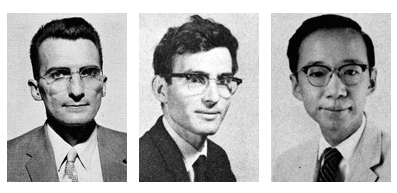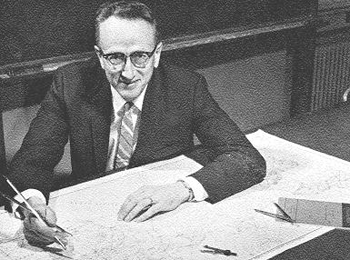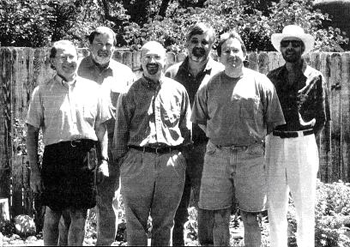MSC 01 1110
1 University of New Mexico
Albuquerque, NM 87131
Physical Location:
Bandelier West & East
Phone: (505)277-5041
Fax: (505)277-3614
geography@unm.edu
MSC 01 1110
1 University of New Mexico
Albuquerque, NM 87131
Physical Location:
Bandelier West & East
Phone: (505)277-5041
Fax: (505)277-3614
geography@unm.edu
Geography at the University of New Mexico became an official department in 1961. Prior to formal departmental status, courses in geography were taught in other disciplines exploring human relationships with the environment.
![]()
The Early Years - Geography without a Department
Geography first appeared as an academic subject at the University of New Mexico in 1917. From that time on, it appeared and disappeared, sometimes as a 'minor,' sometimes as a 'division,' and, finally, in 1961 a department was established. Why it had such a fluctuating presence is anyone's guess. However, the discipline has had a similar history in other American universities. Because geography is both a physical and a social science, it is difficult to place in the rather rigid departmentalization that has characterized American institutions of higher learning. C. T. Kirk of the Geology Department offered four courses in 1917 that would normally be considered geography. In 1934, a significant change occurred expanding geographic offerings beyond the Geology Department. Donald Brand was appointed Professor of Anthropogeography and, shortly thereafter, Chair of the Anthropology Department. The courses Brand taught all had a strong geographic component. For example, in 1934 he taught Anthropogeography, Geography and Archaeology of New Mexico, Climatic Factors in Anthropology, and Cultural Geography of the World. At that time, Anthropology was a fairly inclusive department also offering Sociology, Criminology, and Social Organization. Meanwhile, other departments began offering courses that are generally considered geography or that have a strong geographic component.
![]()
The Geography 'Minor'
In 1941, geography offerings were brought together, administered by a committee chaired by Professor Brand, and described as a 'minor' in geography. The committee appointed to administer this program consisted of the people from the departments who taught the courses: Brand of Anthropology, Northrop and Bostwich of Geology, Bell of Biology, Sorrell of Economics and Business Administration, and Holzer and Workman of Physics.
![]()
Regional Geography--Introducing the 'Service' Function
In 1950, Wilfrid Kelley, a graduate of the University of Michigan and an Assistant Professor of geology, was named 'coordinator' of a set of geography courses that would satisfy 'group requirements' in the College of Arts and Sciences. These courses did not constitute a major or a minor, and there was a new emphasis on regional courses. A reason for this shift in emphasis may be found in the 1953 catalog, which says that the geography curriculum was designed to meet the educational requirements for 'geography' in the U.S. Civil Service examinations. At that time, the Foreign Service examinations included a significant emphasis on places and place names. From the point of view of the professional geographer, an offering of largely regional courses makes a statement that the science is primarily descriptive and idiographic. It also brands the geography curriculum as basically one that provides services to other schools and disciplines - education, history, and political science, for example. It tends to emphasize factual information and downgrades geography as a science. In fact, the 'minor' group created at the beginning of World War II was more systematic and topical, and more scientific, and, therefore, more representative of modern geography, than the postwar 'group requirements' offered. In 1952, geography became a 'division' in order to meet a growing demand for the subject, and this status continued for the next nine years. Changes in the size of the division and course offerings were not substantial over this period. By 1959, the curriculum included regional courses in Eastern Asia and Western Europe and two 'problems' courses to cater to students' interests not met by standard course offerings. In 1955, Kelley was replaced by Burton L. Gordon. Gordon had taken his Ph.D. in geography at Berkeley, as had Brand. Three years later, Gordon was joined by Yi Fu Tuan, another Berkeley Ph.D. The emphasis on regional courses continued, as the mid-1950s was a period of growth in interest in foreign places.
![]()
Departmental Status
Finally, in 1961 the division was advanced to the status of a department, and students could graduate with a major in geography. Gordon and Tuan constituted the entire faculty at first; in 1963 they were joined by Conrad Aub, a Cambridge graduate. The geography curriculum included two 100 level courses: Physical Geography and World Geography; two 200 level courses:Physical Geography and Economic Geography; four 300 level courses, all of them regions: South America, Middle America, North America, and Western Europe; two 400 level courses, one of which, Conservation, was taught in the Biology Department and the other was a Problems course; and a 500 level Problems course was also listed.

Figure 1. The three earliest members of the Department of Geography, University of New Mexico - from left to right: Burton L. Gordon, Yi Fu Tuan, and Conrad Aub.
The growth of geography as a separate discipline at the University of New Mexico began with the appointment of Richard E Murphy (Ph.D., Clark) as Chair. Murphy had taught at Wyoming and Hawaii, where he had seen the two extremes of departments: one was small, providing only a service function; the other was large and well-established, offering the Ph.D. He envisioned the latter for the only institution of higher learning in New Mexico that offered a geography degree at the time.

Figure 2. Richard Murphy, Chair, Department of Geography, 1965-81.
![]()
The Boom Period - The Growth of a Modern Department
Murphy suggested a number of changes that would begin to move the Department away from solely a service function toward a substantive program emphasizing the science of geography. Murphy moved quickly to establish a sound geography program. Within five years he had (1) added four more full time faculty members, (2) introduced a graduate program leading to the M.A. degree, and (3) systematized and greatly increased course offerings, including graduate level seminars. At the end of a decade (1975), the faculty had been increased to eight. Changes in faculty brought changes in program emphasis. The post-war 'quantitative revolution' in Geography arrived in New Mexico. During this time, the Department developed a research and publication focus as the university changed into a major research institution.

Figure 3: The Department of Geography moved from Hodgin Hall (top, the oldest building on campus) to Bandelier East (lower left, Geography Laboratories) and Bandelier West (lower right, Geography and EDAC offices) in the early 1980s.
In the early 1980s, faculty members voted to emphasize "applied geography." In part this was fortuitous, because there were already in place strong programs in cartography, photogrammetry, remote sensing, and land use planning. In part it was a response to the students of that time who wanted degrees that prepared them for career positions. Many other departments of geography were moving in that direction as well. One very tangible aspect of this commitment was the creation of an internship program associated with TAC (Technology Application Center), a NASA funded center designed to transfer technology to the private and public sector. TAC was later renamed, becoming the Earth Data Analysis Center (EDAC). In the mid and late 1980s, the Department suffered a temporary setback due to faculty transitions, budget constraints and limited support. It reinvented itself in the early 1990s by shifting its emphasis, which up until this point had been on breath with only limited scope for specialization.
![]()
Emphasis on Environmental Analysis and Geographic Information Science In 1992, Geography's mission shifted to an emphasis on environmental analysis and geographic information science (GI Science). The demand for individuals with a background in environmental analysis and GI Science was expanding rapidly. In practice this meant hiring new faculty who specialized in physical geography/environmental modeling and GI Science. The department chose to emphasize a set of geographic techniques that facilitated the analysis of complex environmental problems. Great strides had been made in the development of geographically referenced databases and the analysis of remotely sensed data. But the application of the modeling aspects of these techniques to environmental problems was still being developed in the early 1990s. The Department of Geography at UNM wanted to help open this research frontier, which interfaced well and complimented the Biology, Earth and Planetary Sciences, and Economics programs at UNM. In spring, 1995, Olen Paul Matthews was hired to be the new Chair of the Department to help implement this new vision.

Figure 4. Olen Paul Matthews, Department Chair One of the goals for the Department was to increase grant productivity.
In 1998 with some of the new faculty on board, Department members began to look seriously for grants. The idea was to couple environmental modeling within a GIS context so that water transfers and their economic consequences could be examined. Five members of the Department were included with an unidentified prospective hire being penciled into the grants. To round out the research team, a groundwater hydrologist and three economists were added. Both a NSF and an EPA grant were funded at a combined total of $1.1 million. The combined project started in the spring of 2000 and continued for 3.5 years. Several major publications were produced by the project.

Figure 5. The faculty of the Department of Geography, 2000 (from left to right, Matthews, Williams, Snell, Scuderi, Gregory, and Cullen; missing Morain).
The graduate program continued to attract quality students, particularly in the combined use of environmental analysis and GI Science. Between 1991 and 2005, the Department produced 80 Master's students or 5.33 graduates per year. Table 1. M.A. and M.S. degrees and last known employment (1991- 2005)
| Category | Number |
| Federal Agency | 15 |
| Consulting Firm | 13 |
| PhD Program | 11 |
| University Research Facility | 9 |
| National Research Lab (Sandia, Los Alamos) | 9 |
| College Faculty and Post Secondary Teaching | 5 |
| Local Government | 5 |
| State Agency | 4 |
| K - 12 Education | 3 |
| Other/Retired/Unknown | 6 |
![]()
Recent Planning and the Department's New Focus
In the 2000/2001 academic year the department was at seven faculty members and had a growing number of undergraduate majors (47) and graduate students (26). A graduate program review was conducted that year which was generally favorable. Unfortunately, three faculty members were lost at the end of the 2001-2002 academic year. With only four tenure track faculty members, a large part-time faculty budget was used to fill the gap. New Mexico is blessed with many virtues and is a wonderful place for retired geographers. The Department takes advantage of local retired talent such as Don McTaggert, John Campbell, Hal Jackson, Frank Pucci, and many others. This has been a practice dating from the first shrinkage in the Department in the late 1980s and early 1990s. As a result of this talent, the Department has been able to continue providing quality teaching at the undergraduate and graduate levels despite periodic budget and administrative constraints. Today, the department has recovered with 51 majors in 2008 (Fall) and 10 MS degrees granted in the 2006/07 academic year. The department currently has six tenure track positions and will be hiring an "outside" department chair in the 2008-2009 academic year. In 2006 three outside reviewers visited the department to help plan for the future. The following academic year the department went through an academic program review. The result of this two year planning process has been a complete rejuvenation of the department's faculty, focus, and curriculum. The Geography Department's focus brings the department into the center of the discipline. The intersection between human geography, physical geography, and geographic information science provides an integrative perspective on a wide variety of important issues facing society.

Traditionally, conceptual lines have been drawn between different disciplines in the social and physical sciences. Although geography attempted to overcome these schisms by incorporating biophysical, social, and cartographic sciences (now GI Science) under one disciplinary roof, the attempt was not always successful. An exception is at the center of the discipline where human-environmental relationships overlap and form a broadly based integrative spatial perspective. Today, many geographers still identify with specializations within physical geography, human geography or geographic information science. But increasingly, the cutting edge of the discipline is where specializations overlap. Many geographers being educated today fall in the middle of the discipline. Examples include natural hazards, water resources, landscape ecology, as well as some regional geographers. This middle ground is the new specialization within the department. Every new hire need not be exactly in the "center", but must have broad competence in the different aspects of the discipline. The department will focus on hiring the best available faculty members. The goal is to move the department incrementally to the "center". Practical reasons also exist for moving to the "center" of the discipline. With a limited number of faculty members, flexibility in teaching is required. Moving the concentration to the center of the discipline provides the greatest flexibility and redundancy in teaching. Preferably, all faculty members should be able to teach the basic core courses.
![]()
The Future
Geography at the University of New Mexico is more vibrant than ever. With a continued emphasis on the intersection between environmental management and GI Science, our vision is to be recognized both regionally and nationally for excellence in research and teaching in these areas. Our current faculty have revitalized the department and its capacity to reach these goals.